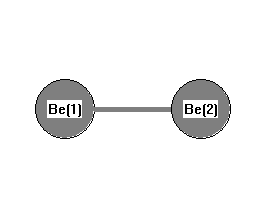Jump to
S2C1
Energy calculated at CCSD(T)=FULL/TZVP
| | hartrees |
|---|
| Energy at 0K | -29.239991 |
| Energy at 298.15K | -29.237543 |
| HF Energy | -29.116667 |
| Nuclear repulsion energy | 3.341150 |
The energy at 298.15K was derived from the energy at 0K
and an integrated heat capacity that used the calculated vibrational frequencies.
Geometric Data calculated at CCSD(T)=FULL/TZVP
Point Group is D∞h
Cartesians (Å)
| Atom |
x (Å) |
y (Å) |
z (Å) |
|---|
| Be1 |
0.000 |
0.000 |
1.267 |
| Be2 |
0.000 |
0.000 |
-1.267 |
Atom - Atom Distances (Å)
| |
Be1 |
Be2 |
| Be1 | | 2.5347 |
Be2 | 2.5347 | |
 More geometry information
More geometry information
Electronic energy levels
Charges, Dipole, Quadrupole and Polarizability
Jump to
S1C1
Energy calculated at CCSD(T)=FULL/TZVP
| | hartrees |
|---|
| Energy at 0K | -29.195113 |
| Energy at 298.15K | -29.193133 |
| HF Energy | -29.114758 |
| Nuclear repulsion energy | 4.122187 |
The energy at 298.15K was derived from the energy at 0K
and an integrated heat capacity that used the calculated vibrational frequencies.
Geometric Data calculated at CCSD(T)=FULL/TZVP
Point Group is D∞h
Cartesians (Å)
| Atom |
x (Å) |
y (Å) |
z (Å) |
|---|
| Be1 |
0.000 |
0.000 |
1.027 |
| Be2 |
0.000 |
0.000 |
-1.027 |
Atom - Atom Distances (Å)
| |
Be1 |
Be2 |
| Be1 | | 2.0545 |
Be2 | 2.0545 | |
 More geometry information
More geometry information
Electronic energy levels
Charges, Dipole, Quadrupole and Polarizability
